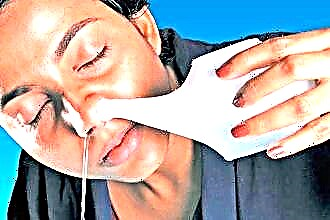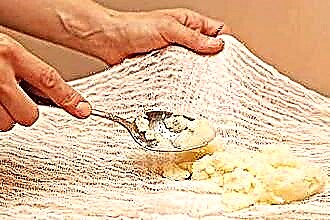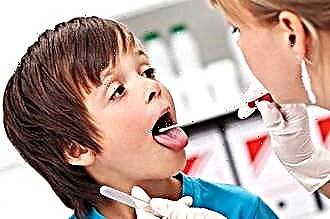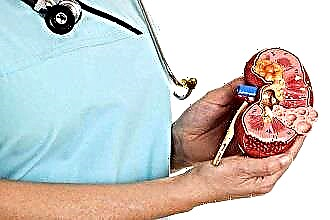To avoid the development of complications, any disease requires timely and correct treatment. To choose the most effective therapy, it is necessary to find out the causes of the disease and the symptoms accompanying it. It is also extremely important to choose the right drugs for the treatment of vasomotor rhinitis, because this is the only way to reduce the likelihood of complications and the transition of the disease into a chronic form. In the complex therapy of this disease, drug treatment, surgery, and the use of traditional medicine recipes are effective.
Diagnostics
 In order to choose the right tactics for treating rhinitis in adults, it is necessary to analyze the possible causes of the disease, accompanying symptoms and find out the type of rhinitis. There are a number of diagnostic procedures indicated for suspected vasomotor rhinitis.
In order to choose the right tactics for treating rhinitis in adults, it is necessary to analyze the possible causes of the disease, accompanying symptoms and find out the type of rhinitis. There are a number of diagnostic procedures indicated for suspected vasomotor rhinitis.
- The specialist analyzes the patient's complaints, examines the anamnesis. At this stage, it is important to find out how often the patient has a stuffy nose, whether there have been any previous manifestations of allergies, the nature and strength of mucous secretions, the seasonality of the disease, the reaction of the vessels to changes in weather conditions, the relationship of the disease with physical activity, body position, and taking medications.
- The doctor examines the nasal cavity, assessing the degree of enlargement and swelling of the turbinates, the color of the nasal mucosa. Also, such an examination reveals the presence of spines or ridges in the nasal cavity, curvature of the nasal septum.
- It is recommended to do a general blood test, which allows you to determine the presence and severity of the inflammatory process in the body, the presence of a bacterial infection, the level of eosinophils, an increased number of which is an indicator of an allergic reaction.
- Blood donation for allergy tests helps to determine the source of the allergy, provided there is an increased level of eosinophils.
- X-ray of the nasal cavity allows you to exclude sinusitis, to find out if there are polyps in the nasal strips and other possible pathologies of the nose.
Treatment
If the diagnosis is confirmed, therapy should be started immediately. For the complex treatment of a runny nose and nasal congestion, drugs are used, the action of which is aimed both at combating the cause and at alleviating symptoms and strengthening the immune system. In this case, you may need to consult an otolaryngologist, a neuropathologist (in the case of neurological disorders), as well as the help of an endocrinologist (in case of hormonal abnormalities).
It is possible to treat vasomotor rhinitis with conservative methods (medication and physiotherapy), but when they are ineffective, surgery is indicated.
Medication methods:
- For the treatment of rhinitis, vasoconstrictor drugs (Nazivin, Nazol, Evkazolin) are used, which reduce swelling of the nasal mucosa and eliminate congestion. However, it should be remembered that such funds must be used strictly according to the instructions, not exceeding the permitted periods of use.
Important! The use of vasoconstrictor drugs for more than two weeks can lead to addiction and the development of a drug-induced form of rhinitis.
- Hormone-containing nasal sprays (Nasonex) are more effective and safe than vasoconstrictor drugs, since they are not addictive and are practically not absorbed into the general bloodstream. Such medicines should be used in long courses.
- In the treatment of chronic rhinitis, injections into the nasal mucosa are shown, containing substances (novocaine, hydrocortisone), the action of which is aimed at strengthening the walls of blood vessels, reducing their size and normalizing local blood flow.
 If the allergic nature of the common cold is determined, then antiallergic sprays and drugs (Fenistil, Cromhexal, Loratadin, Zodak) are used for treatment.
If the allergic nature of the common cold is determined, then antiallergic sprays and drugs (Fenistil, Cromhexal, Loratadin, Zodak) are used for treatment.- Rinsing the nasal cavity with pharmacy saline solutions (Aquamaris, Physiomer, Salin, Aqualor) allows you to liquefy mucus and simplify blowing out. You can also prepare a saline solution at home by dissolving five grams of rock salt in a liter of clean drinking water.
Physiotherapy procedures include:
- Phonophoresis is a procedure in which a solution of hydrocortisone (a hormone of the adrenal cortex) is exposed to the nasal mucosa. With the help of ultrasonic waves, it is possible to more effectively deliver the drug into the tissues.
- Electrophoresis is a method that allows you to strengthen the tissues of the nasal cavity by normalizing the permeability of its cells. For this procedure, tampons soaked in saline are placed in the nasal passages and special electrodes are attached. Electrophoresis can help reduce swelling and remove mucus.
- To reduce the amount of plasma in the nasal cavity, laser therapy is used, which makes it possible to reduce edema, as well as to normalize the work of blood vessels.
How to treat vasomotor rhinitis when conservative methods are ineffective? In such a situation, surgical methods are used. With the help of the operation, the enlarged vessels are removed, which helps to reduce edema, and restore nasal breathing.
There are such methods of surgical intervention as:
- electroplasma coagulation;
- destruction of blood vessels using ultrasound;
- laser destruction.
A procedure such as septoplasty also refers to the surgical treatment of chronic nasal congestion. This method is used to eliminate polyps, align the nasal septum.
Traditional methods of treatment
Traditional medicine offers a large number of drugs and remedies that accelerate the recovery of chronic rhinitis. Therefore, often in cases where the disease is at an initial stage, a runny nose can be cured using an integrated approach, including drug treatment and alternative medicine methods (herbal infusions, decoctions, ointments and nasal drops are used).
So for washing the nasal cavity, in order to moisturize the mucous membrane and remove secretions, use:
- A solution of honey, which has a pronounced antiseptic effect. To prepare the product, add 7 grams of honey in 200 milliliters of heated (37 degrees) boiled water and stir until completely dissolved. The resulting solution is instilled into each nasal passage several times a day.
- A broth prepared on the basis of medicinal plant components such as oak bark, mint, sage. All components are taken in equal parts, crushed, mixed, poured with water (20 grams of dry collection per two hundred milliliters of water) and boiled for fifteen minutes. The resulting broth is cooled, filtered and used to rinse the nasal passages three times a day.
Drops are a popular and effective treatment for the common cold. There are many recipes for their preparation.
- Kalanchoe or aloe juice, squeezed from fresh leaves, is instilled eight drops into each nasal passage three times a day.
Important! Before using various drugs, it is important to make sure that there is no individual intolerance to the components that make up them.
- Beet or carrot juice squeezed from chopped fresh vegetables is also used. The agent is instilled into the nose, two drops three times a day. Useful applications in the nasal passages using cotton swabs dipped in the juice of these vegetables.
- Birch sap is also used in the treatment of the common cold. This remedy helps to thin and remove mucus, as well as strengthen local immunity.It is necessary to instill two drops of juice into each nasal passage five times a day.
Along with drops and solutions for rinsing the nose, the use of medicinal ointments prepared according to the recipes of traditional medicine is effective.
- On the basis of petroleum jelly and crushed walnut leaves or calendula flowers, you can prepare an ointment. The resulting product is placed alternately in the nasal passages three times a day until complete recovery.
- You can also make an effective ointment based on peppermint oil and honey, taken in a one to two ratio. This ointment should be used three times a day until complete recovery.
- A preparation for lubricating the nose can be prepared by taking equal amounts of honey and St. John's wort oil. It is necessary to treat the nasal passages with such a means at least five times during the day.

To quickly remove the mucus accumulated in the nasopharynx, massage can be applied in the area of the wings of the nose and maxillary sinuses.
It is necessary to carry out the procedure by circular motions with fingers and small taps. To increase the effectiveness of the procedure, massage can be done using essential oils such as fir or lavender.
One of the best ways to speed up recovery are procedures aimed at raising local and general immunity. For this, decoctions and infusions of medicinal herbs should be used. Among the most popular recipes for traditional medicine are:
- Herbal infusion based on chamomile, yarrow, nettle, raspberry and thyme leaves. All ingredients are mixed in equal amounts and added to clean water in the ratio of two large spoons of collection to 500 milliliters of water. Then the resulting solution is boiled for ten minutes, filtered and applied in half a glass 30 minutes before meals for a month.
- A decoction made from a mixture of rose hips (15 grams), string (10 grams), lingonberry leaves (3 grams), field horsetail (10 grams) and birch buds (5 grams), has an immunostimulating, antibacterial and anti-inflammatory effect. For its preparation, the dry collection is poured with hot water, at the rate of a tablespoon per glass of liquid, insisted overnight, filtered and taken half a glass thirty minutes before meals three times a day.
- Also useful in the treatment of rhinitis is an infusion made from an herbal mixture of elecampane root, calamus (one tablespoon each), tricolor violet, wild rosemary, coltsfoot herb (two tablespoons each) and citric seed (three tablespoons). All components must be crushed, mixed and poured with boiling water at the rate of a tablespoon of collection per glass of liquid. Insist during the night, strain, apply half a glass four cuts a day before meals.
Prophylaxis
In order to significantly reduce the likelihood of rhinitis, and prevent relapses, it is necessary to follow simple recommendations aimed at preventing the disease:
- timely treatment of various diseases that have a negative effect on the tone of blood vessels;
- exclusion of factors that increase the risk of disease.
This requires:
- give up habits such as smoking and alcohol abuse, which have a negative effect on the elasticity of blood vessels;
- enrich the diet with fortified food, as well as food that helps to strengthen and restore the walls of blood vessels (seafood, carrots, cabbage, tomatoes, bananas, apples, beans, pectin);
- accustom the body to sudden changes in temperature and humidity using the procedure of regular gradual hardening;
- regularly ventilate the room, take walks in the fresh air;
- ensure adequate sleep (at least eight hours a day);
- to provide moderate physical activity, contributing to the normalization of the general tone of the blood vessels;
- avoid stressful situations, nervousness;
- avoid contact with odors and substances that can cause an allergic reaction (tobacco smoke, strong odors of paint, varnish).

 If the allergic nature of the common cold is determined, then antiallergic sprays and drugs (Fenistil, Cromhexal, Loratadin, Zodak) are used for treatment.
If the allergic nature of the common cold is determined, then antiallergic sprays and drugs (Fenistil, Cromhexal, Loratadin, Zodak) are used for treatment.

